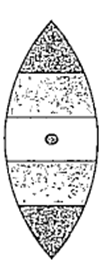 Multiple Choice Questions
Multiple Choice QuestionsThe light reflected by a plane mirrormay form a real image
if the rays incident on the mirror are converging
if the rays incident on the mirror are diverging
under no circumstances
if the object is placed very close to the mirror
A.
if the rays incident on the mirror are converging
Light reflected by a plane mirror may form a real image only when the incident ray is converging.
A convex is made up of three different materials as shown in the figure. For a point object places on its axis, the number of images formed are

5
1
3
4
Light appears to travel in straight lines because
light consists of very small particles
the frequency of light is very small
the velocity of light is different for different colours
the wavelength of light is very small
In Young's double slit experiment, the central bright fringe can be identified
as it is narrower than other bright fringes
by using white light instead of monochromatic light
as it has a greater intensity than other bright fringes
as it is wider than other bright fringes
An object is placed 12 cm to the left of a converging lens of focal length 8 cm. Another converging lens of 6 cm focal length is placed at a distance of 30 cm to the right of the first lens. The second lens will produce
a virtual enlarged image
no image
a real inverted image
a real enlarged image
Whenever a hydrogen atom emits a photon in the Balmer series, it
may emit another photon in the Paschen series
need not emit any more photon
may emit another photon in the Balmer series
must emit another photon in the Lyman series
To increase both the resolving power and magnifying power of a telescope
the focal length of the objective has to be increased
both the focal length and aperture of the objective has to be increased
the wavelength of light has to be decreased
the aperture of the objective has to be increased
In the Bohr model of the hydrogen atom, let R, V and E represent the radius of the orbit, the speed of electron and the total energy of the electron respectively. Which of the following quantity is proportional to the quantum number n ?
VR
RE
In a sample of radioactive material, what percentage of the initial number of active nuclei will decay during one mean life ?
63 %
69.3 %
37 %
50 %
